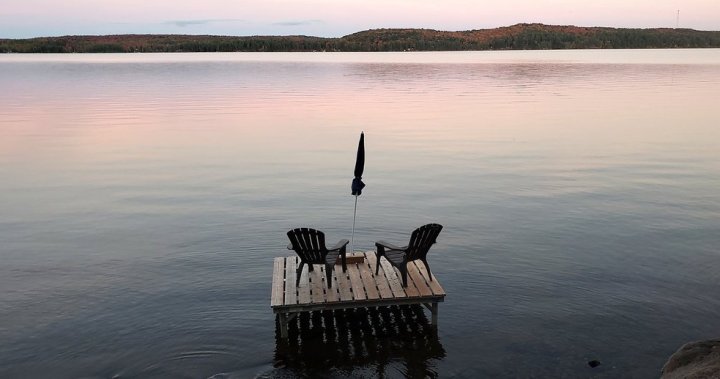Uncategorized
Dreaming of a lakeside cottage but can’t afford it? Co-ownership could open that door

A lakeview cottage with cosy rooms, a sandy beach nearby and a dock to gaze into the sunset was the dream for Corrine Evanoff.
“For years, I’ve been on this journey of trying to find a cottage that would work for us,” she said.
But Evanoff and her husband didn’t want to incur the burden of constant cottage maintenance — spending vacation days fixing decks and pruning trees. They opted instead to rent over the years, still hoping to one day buy.
Then, it happened. They found a cottage not too far from home — for a fraction of the price they thought they’d have to pay, thanks to fractional ownership.
Also called co-ownership, it allows people to buy a share of a property with others, whether it’s family, friends or even strangers.
Affordability sits at the heart of fractionally owned cottages. Many Canadians still find themselves priced out of the market, even as cottage prices have declined from peaks seen during the pandemic.
Re/Max brokers and agents anticipate a national average price increase of about 1.8 per cent across the Canadian recreational market in 2025, a May report by the real estate firm, showed.
On their first visit to check out a prospective cottage last fall, Evanoff recalled walking into a lake-facing cottage with large windows at Frontenac Shores in Cloyne, Ont., about 300 kilometres northeast of Toronto, and was sold.
“We sat in these Muskoka chairs on the beach and our feet are in the water, and I just felt the stress shredding off me,” she said.
“This is the dream that I’ve been dreaming for all these years … and this is within reach.”

Evanoff and her husband now own one-tenth of a million-dollar cottage, costing them less than $100,000 for their share — and affording them five weeks a year at the property.
Fractional ownership of a cottage is not like a timeshare, said Realtor Mike Lange, who has been dealing with co-owned cottages for about seven years in Kawartha Lakes, Ont.

Get daily National news
Get the day’s top news, political, economic, and current affairs headlines, delivered to your inbox once a day.
“With a timeshare, you put your name in requesting a location, you have no guarantee that that’s going to be available,” he said. “There’s been a lot of heartaches over them over the years.”
Timeshare properties can be owned by for-profit corporations, leaving less autonomy for those staying there.
Don Smith, who co-owns a property in Kawartha Lakes, bought into a cottage in the mid-2000s after he saw a newspaper ad about fractional cottage ownership.
“I was in the staff room reading the newspaper as a mathematics and computer studies teacher,” he recalled. “As a math teacher, that caught my eye: What’s this fraction all about, this cottage, this idea?”
For the Smiths, fractional ownership wasn’t a financial investment but a lifestyle investment that has paid off over the past two decades.
“This is where my daughter learned to swim, that’s where my daughter learned to kayak, that is when my daughter had learned to appreciate animals.”
But it may not be for everyone.
Smith said fractionally owned cottages are usually 100 per cent debt-free. That means new co-owners typically can’t secure a mortgage against the property from traditional banks and will have to rely on personal loans or a line of credit to buy their share.
Personal touches to the cottage can also be missing with fractional ownership and people can’t just show up at any time, he said.
“It’s not like you can personally put all your favourite pictures and put all of the junk that you don’t want in your home garage and take it up there and leave it,” Smith said.
Real estate developer John Puffer has years of experience building cottages and selling them in fractional ownership arrangements in Ontario’s cottage country regions.
When he first got into the business, Puffer assumed the buyers would mostly be people in their 30s with young families. Instead, they happened to be people in their 50s and 60s, buying cottage shares for their adult children and grandchildren, or people who don’t want to commit the dollars and worry about maintenance.
“That is part of the Canadian cottage experience in Ontario … that’s where families congregate at the cottage and (it’s) multi-generations,” said Puffer, president of Chandler Point Corp.
Tanya Walker, litigation lawyer and managing partner at Walker Law, suggests potential buyers should get a good contract lawyer and treat the contract “as if it’s a pre-nuptial agreement” before signing on to be a co-owner.
She said buyers going into fractional ownership should ask questions about who the other co-owners are, the voting rights people get for their share and what happens when they want to sell their stake.
Walker added it’s also important to look into who manages the property, the financials of the property as well as how much time you’ll get to use the cottage and when.
Puffer said people really have to understand what they’re buying into. He suggested people read the contract and find out who’s in control, what their obligations are, and talk to people who already own.
For Evanoff and her husband, it will be their third time heading up to the Frontenac Shores cottage next month.
“It’s like, wow! That just seems like a gift,” she said.
“This (fractional ownership) seems like the best-kept secret but I think it’s going to catch on … and you’re going to see a lot of people tap into this market.”
Uncategorized
Blue Jays reinstate Gimenez from injured list

TORONTO – The Toronto Blue Jays reinstated second baseman Andres Gimenez from the 10-day injured list Tuesday and designated infielder Buddy Kennedy for assignment.
Gimenez, a three-time Gold Glove award winner, missed five weeks with a left ankle sprain.
Related Videos
The moves were announced shortly before the Blue Jays opened a three-game series against the visiting Chicago Cubs.
Entering play Tuesday night, Gimenez had five homers, 23 RBIs and a .218 average.

Get daily National news
Get the day’s top news, political, economic, and current affairs headlines, delivered to your inbox once a day.
Kennedy had one hit in two games for the Blue Jays. He also played four games for the Philadelphia Phillies earlier this season.
This report by The Canadian Press was first published Aug. 12, 2025.
© 2025 The Canadian Press
Uncategorized
Man dead, another in custody after stabbing in Toronto’s east end


Around 2:30 p.m., Toronto police said they were called to the area of Woodbine and Duvernet avenues for reports someone had been stabbed inside a neighbouring home.
Source link
Uncategorized
Jays’ Shapiro says he wants to remain with team

TORONTO – Blue Jays president Mark Shapiro declined to comment on contract extension talks Tuesday but said he wants to remain with the club and that team ownership has been “reciprocal in that desire.”
Shapiro, who also serves as chief executive officer, is in the final year of his contract.
“When I think about alternatives, I’ve never been a grass is greener guy,” he said in a pre-game availability. “Twenty-four years in one place in Cleveland and 10 years here now.
Related Videos
“So it’s the appreciation for what I have and the people that I get to work with every day, the city that I work in and the country that I live in, those things are drivers for me to remain here.”
Shapiro, 58, joined the club in 2015 and signed a five-year extension in January 2021.

Get daily National news
Get the day’s top news, political, economic, and current affairs headlines, delivered to your inbox once a day.
He took questions from reporters for about 20 minutes in a rare in-season media session. Shapiro was asked directly whether there had been discussions with team owner Rogers Communications on a new deal.
“Sure, yeah, I mean I think (it’s) not appropriate for me to comment beyond the fact that what I just said is I want to remain here,” Shapiro said. “And I can also say that both (Rogers executive chair) Edward (Rogers) and (Rogers president/CEO) Tony (Staffieri) have been reciprocal in that desire.”
It has been a worst-to-first campaign for Canada’s lone Major League Baseball team. The Blue Jays finished last in the American League East division standings last season but have enjoyed a stellar season in 2025.
Toronto entered Tuesday night’s game against the visiting Chicago Cubs with the best record in the AL at 69-50.
This report by The Canadian Press was first published Aug. 12, 2025.
© 2025 The Canadian Press
-

 Uncategorized2 months ago
Uncategorized2 months agoAccording to Dior Couture, this taboo fashion accessory is back
-

 Uncategorized2 months ago
Uncategorized2 months agoThese ’90s fashion trends are making a comeback in 2017
-

 Uncategorized2 months ago
Uncategorized2 months agoThe old and New Edition cast comes together to perform
-

 Uncategorized2 months ago
Uncategorized2 months agoUber and Lyft are finally available in all of New York State
-

 Uncategorized2 months ago
Uncategorized2 months agoNew Season 8 Walking Dead trailer flashes forward in time
-

 Uncategorized2 months ago
Uncategorized2 months agoMeet Superman’s grandfather in new trailer for Krypton
-

 Uncategorized2 months ago
Uncategorized2 months ago6 Stunning new co-working spaces around the globe
-

 Uncategorized2 months ago
Uncategorized2 months agoThe final 6 ‘Game of Thrones’ episodes might feel like a full season







